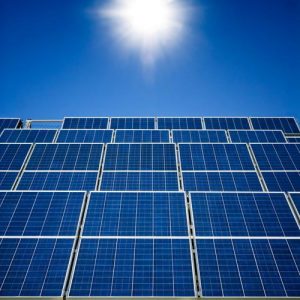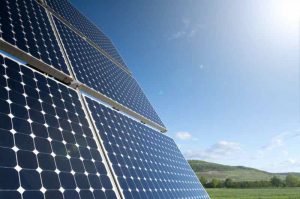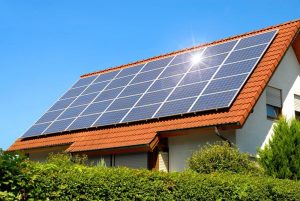How to make best use of Solar and other policy in Uttar Pradesh to save on electricity bill?
Government Of India, on 19th Feb. 2019, has approved phase II of Grid Connected Rooftop and Small Solar Power Plants Programme”. The program aims to achieve a cumulative capacity of 40 GW ( or 4,00,00,000 kW) RTS plants by 2022 ( over-ambitious target as commented by the Parliamentary Panel) of which 4000MW in the residential sector with Central Financial Assistance and balance in other sectors such as social, Govt. educational, PSUs, etc. UP has been given a target of 60 MW for the residential sector, a very ambitious project requiring a rooftop space of 600 million sq.m. In order to motivate house dwellers, a generous user-friendly subsidy has also been announced. We at Bijli Bachao have studied the policy and would like to bring out the facts for the knowledge of all and how the installation of the rooftop solar panel is a long term benefit for the household dwellers who have a rooftop to spare for installation of the solar panel.
Why GOI is providing subsidy?
A question that may crop up in your mind would be: why the GOI is providing a subsidy and how the investment is going to benefit the GOI. The long term vision of GOI to provide subsidy are as under:
- As part of Intended Nationally Determined Contribution (INDCs), India has committed to increasing the share of installed capacity of electric power for a non-fossil-fuel source to 40% by 2030 with major contribution coming from Solar power plants;
- RTS (Roof Top Solar) plants help in reducing transmission and distribution losses as the generation and consumption point is co-located;
- It helps in tackling day time peak load as the solar generation will help in matching peak load demand;
- Most of the states residential sector enjoys subsidized electricity tariff and to motivate the consumer to install RTS plant. Central Financial Assistance is necessary;
- Long term target to achieve dependence on fossil fuel.
How much of Financial Assistance is available from Central and UP Govt for your RTS project?
GOI has restructured a higher CFA in Phase II and the eligibility is for RTS plant from 1 kWp up to 10 kWp capacity. It is applicable for the consumer under the category LMV1 only. The subsidy is as under:
- 40% up to RTS plant of 3 kWp capacity;
- 20% up to RTS plant above 3 kWp and up to 10 kWp
- The residential sector may install RTS plant above 10 kWp but the CFA will be applicable up to 10kWp only.
- In order to tap the potential of the rooftop of group housing society the same is included in the phase II program for the installation of RTS plant for common area. In this case, the CFA will be limited to 20% for the installation of RTS plant for the supply of power to common facilities. As per GOI guidelines, the capacity eligible for CFA for GHS/ RWA will be limited to 10 kWp per house and total not more than 500 kWp, inclusive of RTS already installed on individual houses in that GHS/ RWA at the time of installation of RTS for common activity. But as per UP guidelines, it is limited to 100 kWp.
Approved rates of UPNEDA: UPNEDA have approved the benchmark cost of RTS plants of 1 to 10 kWp at Rs. 38,000/kWp and Rs. 32000/- for RTS of 10 kWp to 100 kWp. This benchmark cost has been determined based on the tendering system. One can find a difference in the benchmark cost of Rs. 54/Wp on MNRE website as compared to Rs. 38/Wp. Every state has to determine its own benchmark cost and the subsidy applicable from GOI is limited to the mentioned on their website. The CFA will be given based on the benchmark cost determined by the respective State. The actual cost charged by the approved vendor may not be exactly the same any vary depending on the site condition, and the consumer may be required to negotiate the price based on the services and quality of the product offered.
CFA in rupees worked out for various capacity is as under:
| 1kWp | 2kWp | 3kWp | 4kWp | 5kWp | 6kWp | 7kWp | 8kWp | 9kWp | 10kWp |
| 15200 | 30400 | 45600 | 53200 | 60800 | 68400 | 76000 | 83600 | 91200 | 98800 |
Beside GOI subsidy, an additional subsidy of Rs. 15000/kW up to a maximum of Rs. 30000/- is being given by UP State Govt. Refer page no. 15 of UP Solar Policy 2017, detailing the financial assistance by UP Govt. In view of this, the capital cost to be paid by the individual for the RTS plant of 10 kW is as under:
| Watt-peak rating |
1kWp |
2kWp | 3kWp | 4kWp |
5kWp |
| Capital Cost (in Rs.) | 38000-15200-15000=7800 | 76000-30400-30000=15600 | 114000-45600-30000=38400 | 152000-53200-30000=68800 | 190000-60800-30000=99200 |
| Units generated/year | 1679 units/year | 3358 units/year | 5037 units/year | 6714 units/year | 8395 units/year |
| Watt-peak rating |
6kWp |
7kWp | 8kWp | 9kWp |
10kWp |
| Capital Cost (in Rs) | 228000-68400-30000=129600 | 266000-6000-30000=160000 | 304000-83600-30000=190400 | 342000-91200-30000=220800 | 380000-8800-30000=251200 |
| Units generated/year | 10074units/year | 11753units/year | 13432units/year | 15111units/year | 16790units/year |
You will neet free from any shadow, a space of 10 sq.m./kWp on your rooftop.
From the above, you can look at your annual consumption and it is likely that the annual consumption may match with the units generated by the RTS plant. The energy bill will only be towards the fixed charges on your sanctioned load and the electricity duty on the total energy consumed irrespective of the source of generation.
How to apply
The UPNEDA has simplified the system of applying online in its objective of providing a userfriendly platform for the said purpose.
What documents are required for applying online?
- Proof of identity and address of the user (self-attested copy of these: Adhar /voter I-card, bank Passbook, Electricity Bill, Passport, etc.)
- Photograph of the beneficiary.
- Aadhaar Scanned Copy of Aadhaar Card
- Scanned copy of Bank Passbook
- Scanned copy of latest Electricity Bill
- Take Site Photographs (Pre installation) for Apply of Subsidy Form.
- Copy of the invoice
- Technical specifications details Solar Panels and invertors (Downloads Here)
- Bill of Material.
- Site Photographs (After installation)
- Copy of grid clearance /Net meter installation certificate issued by DISCOM. (Copy of Electricity Bill)
- Joint Inspection – Join Commissioning Report (Downloads Here)
Apply online
As a user-friendly pro-active facility, one can apply online and all the issues related to sanction, net-metering, technical specification, approved venders (one can select from the list), billing of capital cost after deduction of subsidy etc. Click here for submitting an online application.
For net-metering, the consumer shall register with the UPPCL/Discom by filling up the form of “Rooftop Solar Photovoltaic Application System.”
List of Firms for installation of Rooftop Solar Power Plant under Capax Mode- (MNRE Phase 2 Program)
MNRE has approved a list of firms that have the capacity and capability to manufacture and install RTS plants up to 10 kWp and the second list of above 10 kWp. One may visit UPNEDA website for the list of firms. The scope of work and technical specifications is also provided by MNRE and the approved firms are bound to supply and install the plants accordingly. The only thing a customer has to make sure is that the firm ensures compliance with the standard specifications and scope of work and shall involve in the work at each stage of execution and enter into a contract accordingly.
Annual Maintenance Contract
The benchmark cost includes the cost of annual maintenance for five years. The annual maintenance most likely is on-demand basis and replacement/repair of the defective component and preventive maintenance like cleaning of the panel will have to be done by the consumer. After five years, the consumer shall enter into a contract for the remaining years of the life of the plant. In view of this, while selecting the vendor, one should be careful to select such vendors who are likely to survive the economic ups and downs and do not default in its maintenance obligation.
The components which can give trouble are not the major ones but the small ones like hardware, cable, securing ties, layout, rat menace, etc. This can be prevented by taking due care during installation and selecting the layout.
Solar Policy
One has to read the RTS plant installation policy along with the Solar policy as the net metering directives are issued in this policy. UP Electricity Regulatory Commission has issued UPERC (Roof Solar PV Grid Interactive System Gross/Net Metering) Regulation, 2019 (RSPV Regulation, 2019) bringing out details of the rules and regulations governing the installation of the rooftop solar system. Anyone who is planning to install a solar system should go through these regulations properly so that he gets the return on investment as planned. Some of the important features to understand are as under:
RTS Plant Capacity
The maximum peak capacity of the grid-connected rooftop solar PV system to be installed by any eligible consumer shall not exceed 100% of the sanctioned load/connected load / contracted demand of the consumer. For example, if you have a sanctioned load of 5 kW, you can go for the plant of max 5 kWp.
Please note that the actual output of RTS plan is about 20% lower (as the rated number is in laboratory conditions), so if you install a 5 kWp plant, you will get an output of 4 kWp.
Metering Arrangement
There are two types of metering arrangement namely
- Gross Metering (clause 10.3) in which the entire power generated is supplied to the grid. Such a system is worth trying when one is planning for Solar Park of higher capacity to have a regular rate of return on his/her vacant land, hospital, educational institute, Govt. installation etc. This is not suitable for a domestic consumer using the rooftop for the purpose of reducing electricity bills.
- Net Metering (Clause 10.4) in which the units imported (plus) and exported (minus) are accounted for in any billing period. The net plus energy consumed is billed as per the prevailing tariff applicable for that slab. If the net is minus, the same is carried forward to the next billing cycle and the process continues up to the settlement period i.e. from first April to next March. Net minus on settlement day i.e. 31st March is compensated at Rs. 2/kWh.
Now following interpretation of the policy is important to consider:
- The policy benefits the consumer in his/her energy bill as the slab applicable for a tariff is at the net energy consumed during any billing cycle meaning thereby billing at the lower slab and benefit at the higher slab; and
- However, the settlement period defined is not favoring to the consumer because of the trend of consumption one can observe in UP i.e. high during April to Sept and low from Oct to Mar, and therefore, may not permit full use of solar power for self-consumption and may have to settle for a surplus solar power during lean months at Ra. 2/kWh as compared to tariff of about Rs. 5/unit.
Retail Tariff LMV-1
In order to provide all related information, we have added information about the electric tariff, supply code and cost data book here it self.
Rate Schedule LMV-1 (visit page number 483 of the tariff given at the link above) is applicable for Domestic Light, fan and power and is applicable for residential purpose and consisting exclusive domestic and mixed load (50 kW and above) for registered society/residential colonies/township getting supply at single point with the condition that at least 70% of the total connected load shall be exclusively used for the purpose of domestic load and balance can be towards commercial purpose. In case, the commercial load ceiling exceeds 30%, the tariff will be charged as per HV-1, a huge increase in the electricity bill of the residential load.
The rates are further categorized as per clause 3 of the Tariff order as detailed in the table below:
| Tariff Clause | Category |
Rate
|
||
| Fixed charges | Unit consumed/month | Unit Charge | ||
| (a) | Rural Schedule | |||
| (a)1 | Lifeline Consumer (Metered) Load less of 1 kW and unit consumption less than 100 units (kWh) | 50/kW/month | Less than 100 units | 3.00/unit |
| (a)2 | Other than Lifeline | 90/kW/month | For the first 100 units | 3.35/unit |
| 101-150 units | 3.85/unit | |||
| 151-300 units | 5.00/unit | |||
| 301-500 units | 5.50/unit | |||
| Above 501 units | 6.00/unit | |||
| (b) | Single Point Bulk supply (more than 50 kW) | 110/kW/month | For any unit | 7.00/unit |
| Electric vehicle Charging with the applicability of Time of the Day tariff. | Nil | NA | 5.90/kWh | |
| For the township, registered societies, residential colonies, multi-storied residential complexes with the restriction that at least 70% of the total contracted demand is used exclusively for domestic use.
Violation will result in shifting of the tariff to HV-1 as given below, and not only this, the tariff will shifts from kWh (active power) to kVAh (total power) and likely to be 5% more on account if pF maintained at 0.95. One should read carefully the responsibility of the franchise (or builder/RWA) to arrange for the audit and provide all relevant information to the consumer to whom the power supply is distributed. Otherwise, the society may get a shock one day of the tariff shifted to HV-1 |
||||
| HV-1 (1 e) | ||||
| Supply at 11 kV | 430/kVA/month | Up to 2500 kVAH/month | 8.32/kVAh | |
| Above 2500 kVAh | 8.68/kVAh | |||
| Supply above 11 kW | 400/kVA/month | Up to 2500 kVAH/month | 8.12/kVAh | |
| Above 2500 kVAh | 8.48/kVAh | |||
| One can calculate the implication of the change of tariff if resorted by the Power Supply Company | ||||
| (c) | Other Metered Domestic Consumer | 110/kW/month | For the first 150 units | 5.50/unit |
| For a connected load of 10 kW and above. the unit for billing will be kVAh | 151-300 units | 6.00/unit | ||
| 301-500 units | 6.50/unit | |||
| Above 501 units | 7.00/unit | |||
| Tax and duties | The applicable tax and duty is 5% on the total bill. | |||
|
|
||||
General Provisions of Rate Schedule 2019-20
It is important for the consumer to understand the general provisions to avoid increased energy bill as detailed in the table below. One should visit the page number to get more details of the content as mentioned in the Table.
| Clause No of Tariff | Page No. of Tariff | Content |
| 5 | 476 | kVAh billing applicability when the Contract demand exceeds 10 KW
|
| 7(i) | 478 | Surcharge and Penalty for delayed payment
1.25%/month up to three months; 2%/month thereafter
|
| 7(ii)a | 478 | Contract demand exceeding sanction demand for domestic consumer
|
| 17 | 481 | On-Line payment:
No transaction for internet banking but transaction charge will be applicable for debit/credit card payment |
Cost Data Book
You will find Cost Date Book issued with the approval of the Regulatory Commission which covers all charges included in the estimate while seeking new connections.
Clause 7 Page 3 of the book reads as follows: ” The total charges payable by the Applicant shall comprise of Processing Fee, Security, Line Charges. All three components shall be clearly and separately mention in the Estimate and receipt issued b the Licensee to the Applicant.” (It is important to note for you that the power supply company pay interest on the security deposit at the end of the financial year)
Clause 11 of the Book also states that connection charges for new connection up to 5 kW may be paid in 18 equal instalments.
You may check the various charges on this document as under:
Processing Fee: Refer page no. 5 of Chapter 2 for all details
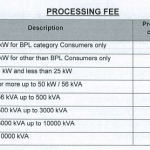
Security: Refer page no. 6 of Chapter 3
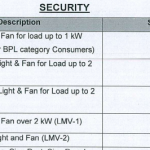
Line Charges: Refer page no. 8 Chapter 4
Line Charges including the cost of meter as provided by the Licensee
| Category | Fixed charges for lines up to 40 meters (in Rs) | Variable line charges beyond 40 meters (in Rs) |
| In the village and having load up to 2kw for domestic and non-domestic light and fan | 1022 | Rs. 340/meter |
| Load below 5 kW but not covered in a category above | 1270 | a. 740/meter for Dist. H.Q.
b. 240/meter for other than Dist.HQ |
| From 5kW and up to 25 kW | 2036 | a. 970/meter for Dist H.Q.
b. 570/meter for other than Dist.HQ |
| Note: The fixed charges are different if the connection is drawn underground and refer Page 8 of the Cost Date Book | ||
Energy Conservation
As the name of our website suggests, it is our endeavor to make efforts and awareness campaigns to save energy (Bijli Bachao). Here are a few of our tips and posts to conserve energy and contain your monthly energy bill in your comfort zone:
- Guest Article: Journey To Net Zero Energy Space
- New BEE Star Rating Standards for Ceiling Fans in India
- Replace old inefficient air conditioners with BEE star rated air conditioners to save electricity
- Replacing old or buying new, why a BEE 5 star rated refrigerator always makes sense
- Air conditioner selection: understand Tonnage, EER, COP and Star Rating
- Why LED lights are better than Fluorescent lights even when lumens per watts are the same
Supply Code (including up to 12th amendment)
The supply code 2005 (including up to 12th amendment) of UP state provides all information in connection with any issue related to connection/disconnection, billing, meter defects, wrong billing, etc. One should read the relevant clause of this code and should address any relevant issue to the applicable Power Supply Company Paschim, madhyanchal, purvanchal, etc. in accordance with the Formats given in the table
Annexure to Supply Code
The annexure providing a format for addressing any issue related to a power supply to any of the Power Supply Company of UP state with reference clause of the Supply Code and Page number provided for understanding the method and address the grievance.
| Annexure to Supply Code | Description | Reference clause of Supply Code | Page No. |
| 3.1 | Existing Consumer Categories and Billing Cycle | 3.7 & 6.1(a) | 74 |
| 4.1 | Application Form for Requisition of Supply of Energy | 4.4 | 74 |
| 4.2 | Indemnity Bond | 4.4 | 77 |
| 4.3 | Owner Consent letter for getting New Supply | 4.4 | 78 |
| 4.4 | Format for Work Completion Certificate and Test Results | 79 | |
| 4.5 | Application Form For Requisition of Temporary Supply of Energy | 4.10 | 83 |
| 4.6 | Procedure for Determination of Connected Load | 4.12 and 4.9 | 85 |
| 4.7 | Format for Disconnection | 4.14 (g) | 86 |
| 4.8 | Format for Intimation to Consumer after Termination of Agreement | 4.14 (i) | 87 |
| 4.9 | Format for Intimation to Consumer after Temporary Disconnection of Supply | 4.37 | 88 |
| 4.10 | Application Form for Enhancement/Reduction of Contract Demand | 4.41(a) & 4.43 (a) | 89 |
| 4.11 | Format for Transfer of Connection/Mutation of Name | 4.44 (b) | 90 |
| 5.1 | Meter Related Complaints or Testing Meter | 5.6 (b) | 91 |
| 6.1 | Format for Application of Advance Payment | 6.4 (b) | 92 |
| 6.2 | Procedure for Filing of Appeal before the Appellate Authority | 6.8 (c) & 7.11 | 93 |
| 6.3 | Assessment in case of unauthorized use of electricity | 6.8 (c) | 96 |
| 6.4 | Inspection Form | 98 | |
| 7.1 | Guaranteed Standards of performance and level of compensation to the consumer for default in each case | 6.5 (c), 7.9 (a & b) | 101 |
| 7.2 | Proforma for Complaints | 7.7.6 | 103 |
| 7.3 | Assessment officer under sec 126(6)(a) and Appellate Authority constituted under Electricity Act 2003 | 7.11 | 104 |
13th Amendment to Supply Code 2005
This is a very important amendment which is applicable to all the bulk consumer as per LMV -1(b) i.e. single point for bulk loads (50 KW and above, supplied at any Voltage) and distributed to many households in the premises by the franchise. The amendment now provides that all future connections in this category shall be a multi-point connection to each apartment in the housing society and also the existing single-point connections to be converted to the multi-point connection if more than 50% of the RWA members opt for a change of tariff from single to multi-point connection.
Now it becomes very important for the members of the RWA to discover the benefit if they prefer to opt for a change. For example, if you consume 1000 units/month with sanctioned load of 7 kW, your bill would have been around 7700/- (excluding 5% towards distribution loss and 8 % towards taxes) whereas, in the revised system as per amendment, it will be 6155/- (excluding tax), a saving of around 20%. The initial cost which will be charged for conversion had to be borne by the consumer, and it looks prudent to opt for a change. But the very pertinent question is the feasibility and how to have a sustainable plan when everyone has become habitual and comfortable with the prevailing system. The important issues that come to everyone mind are:
(a) what is the likely cost?
(2) where the energy meters will be installed for the company person to the readings conveniently?
(3) how the DG supply will be given?
and these issues are the main reason for its non-implementation in any of society even after the passage of one year.
Online Payment
Register yourself with connection ID on the power supply company website to make online payment of electricity bill and pay conveniently without requiring to visit the company office. Visit our website https://www.bijlibachao.com/online-bill-payment/puvvnl-mvvnl-pvvnl-dvvnl-uttar-pradesh-up-electricity-bill-payment-online.html for this purpose.
You may also pay the bill using amazon portal
Customer Care
Customer care is the important requirement for anyone to register his complaint/suggestion/requirement and following may help you
- Write to the nearest power supply company in writing following the form stated in the supply code above.
- Contact customer care no. 1912 and register your complaint
- Download e-nivaran app and address all your issues there
- Write directly to Energy Minister office on this e-mail address [email protected]
About the Author:
Mr Mahesh Kumar Jain is an Alumnus of the University of Roorkee (IIT Roorkee) with a degree in Electrical Engineering who has spent 36 years serving the Indian Railways. He retired from Indian Railways as a Director of IREEN (Indian Railways Institute of Electrical Engineering) and has also served as Principal Chief Electrical Engineer at many Railways. He has performed the responsibility of working as Electrical Inspector to Govt. of India. Mr Mahesh Kumar Jain is having a passion for electrical safety, fire, reliability, electrical energy consumption/conservation/management, electrical appliances. He currently serves as a consultant at Nippon Koi Consortium in the field of power distribution and electric locomotive. More from this author.

